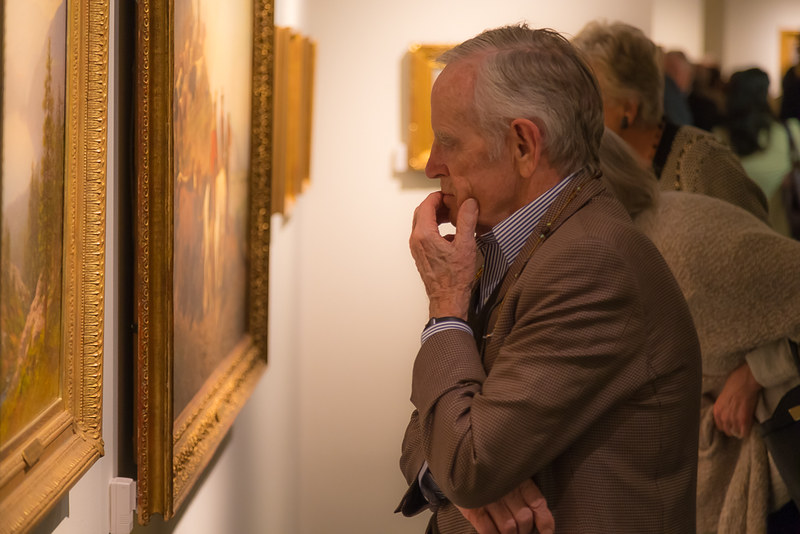
Benjamin Chambers Brown, “Poppies, Antelope Valley,” before 1942 (Photo via Wikimedia Commons Public Domain)
No modern art movement has been as influential as Impressionism. Since the French movement made its debut in the late 19th century, countless artists have found inspiration in the Impressionists' approach to painting. While its influence is famously evident in European genres like Post-Impressionism and Pointillism, it also sparked a smaller movement called California Impressionism.
Artists working in this style embraced several key Impressionist interests, including loose brushwork, rich color, and, most of all, a fascination with the effects of sunlight. In order to master the Impressionists' treatment of light, this new wave of artists adopted an important habit: painting en plein air, or “in the open air.” Perfect for capturing the distinctive glow of the Golden State, plein air painting quickly became a defining feature of 20th-century California painting.
Beginnings of California Impressionism
In 1874, Impressionism emerged in France. Inspired by a desire to capture “impressions” of everyday life and characterized by an avant-garde and unacademic aesthetic, the movement was initially controversial. By the turn of the century, however, it was widely embraced, with artists coming from around the world to study under Paris' finest painters.

Claude Monet, “The Beach at Pourville,” 1882 (Photo via Wikimedia Commons Public Domain)
The movement was particularly well-received by artists in California, who had long since looked to 19th-century French paintings for inspiration. Unlike these earlier models, however, Impressionist works did not revolve around realism or attention to detail; instead, they showcased the atmosphere and emotion of scenery.

Selden Connor Gile, “Stinson Beach,” 1919 (Photo: Oakland Museum of California via Wikimedia Commons Public Domain)
Important Influencers
William Keith
This approach appealed to California-based painters like William Keith, who saw it as a natural fit for landscape painting. Keith was a prominent San Francisco-based painter and pioneer of Tonalism. Following a trip to Paris, he decided “to study altogether from Nature” and adopted an introspective, Impressionist-inspired mindset.

William Keith, “Carmel by the Sea,” ca. 1905 (Photo: The Bridgeman Art Library via Wikimedia Commons Public Domain)
“My subjective pictures are the ones that come from the inside. I feel some emotion and I immediately paint a picture that expresses it,” he said in 1913, according to The Art Institute of Chicago. “The fact that they like it means nothing. Any one who can use paint and brushes can paint a true scene of nature—that is an objective picture. The artist must not depend on extraneous things. There is no reality in his art if he must depend on outside influences—it must come from within.”
While Keith did not consider himself a California Impressionist, he undoubtedly contributed to its emergence in Northern California.
The Society of Six
In addition to Keith, another influence inspired artists in Northern California to adopt an Impressionist style: the 1915 Panama-Pacific International Exposition in San Francisco. This monumental world's fair showcased a selection of Impressionist works not previously seen outside of France, making Impressionism accessible to new audiences.
Members of the Society of Six, an Oakland-based group of painters, were particularly drawn to these pieces. In fact, they had the most profound effect on Selden Connor Gile, the group's founder and leader.

Selden Connor Gile, “Joaquin Miller's House,” 1915 (Photo: Oakland Museum of California via Wikimedia Commons Public Domain)
“Overnight he abandoned his skillful, measured tonalist work in favor of energetic brushstrokes and vivid color,” the University of California Press Blog says. “The conversion of Gile, the captain and leader of the group, became the catalyst for the others,” which included French-born August Gay, Canadian-American William Henry Clapp, and Bay Area natives Maurice Logan, Louis Siegriest, and Bernard von Eichman.
Shortly after viewing this important exhibit, the Society of Six began painting outdoors, culminating in a collection of paintings showcasing eclectic views of the local landscape.

Louis Siegriest, “Gile's House,” 1921 (Photo via Wikimedia Commons Public Domain)
By the early 1920s, these pieces were exhibited in museums in both Northern and Southern California, from the Oakland Art Gallery all the way down to the Los Angeles Museum.
The Laguna Beach Art Association
While California Impressionism took off in Northern California, it eventually emerged in the Los Angeles region as well. Anna Althea Hills, an Ohio-born painter, played a prominent role in its growth. After studying in Paris, Hills moved to Laguna Beach, a coastal city in Orange County, and opened a studio.

Anna Althea Hills, “Sunshine & Shadow-Orange Co. Park, California,” 1915 (Photo via Wikimedia Commons Public Domain)
In 1918, she co-founded the Laguna Beach Art Association, a band of artists who painted “California’s rugged coastlines, verdant hills, vibrant flora and other environmental elements” en plein air. Another notable member of the Laguna Beach Art Association was Benjamin Chambers Brown, an artist so deeply intertwined with the California Impressionist movement that he often signed his work with both his name and the word “California.”

Benjamin Chambers Brown, “Brown Hills on the Russian River,” 1915 (Photo via Wikimedia Commons Public Domain)
This successful association eventually led to the establishment of the Laguna Beach Art Museum, an institution that still “collects California art and only California art, and ranges across all periods and styles, nineteenth-century to present-day.”
Legacy
As avant-garde American movements like Abstract Expressionism emerged toward the middle of the 20th century, California Impressionism gradually fell out of fashion. However, following a revival in the Arts and Crafts Movement in the 1970s, a renewed interest in California Impressionism began to grow.
Since then, it has seen overdue success, with exhibitions popping up across the state showcasing just how historically significant and aesthetically beautiful this underrated genre is.
Related Articles:
Colorful Open-Impressionism Paintings Capture the Beauty of Wine Country
Major Exhibition Explores Van Gogh’s Influence on David Hockney for the First Time
15 Delightful Gifts Perfect for People Who Love Impressionism
Exploring Fauvism’s Expressive and Colorful Contributions to Modern Art
























































































